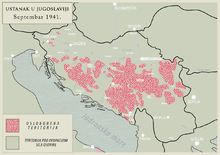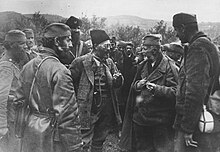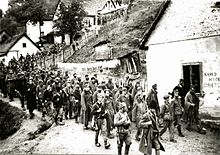Uprising in Serbia (1941)
The Chetnik leader Dragoljub Mihailović abandoned the uprising in late October and entered into negotiations with the quisling government and the Germans in order to destroy the rival Partisans.On 13 May 1941, Josip Broz Tito sent a message to the Comintern stating that the Yugoslav communists were preparing for an uprising that would commence when Germany attacked the Soviet Union.[7] Decision for preparing struggle in Serbia issued on June 23, 1941 at the meeting of the Provincial Committee for Serbia, which was attended by Aleksandar Ranković, Spasenija Babović, Đuro Strugar, Moma Marković, Ivo Lola Ribar, Blagoje Nešković, Vukica Mitrović, Mirko Tomić, Miloš Matijević, Ljubinka Milosavljević, Vasilije Buha and Milovan Đilas.In light of upcoming struggle, communist had to hasten forming of armed groups and collecting weapons and medical supplies.Remaining members were: Milovan Đilas, Edvard Kardelj, Ivan Milutinović, Aleksandar Ranković, Rade Končar, Franc Leskošek, Sreten Žujović, Ivo Lola Ribar and Svetozar Vukmanović.Here was established Supreme Staff for Serbia with Žujović, Filip Kljajić, Branko Krsmanović, Nikola Grulović and Rodoljub Čolaković as members.Communists pointed time had come for armed struggle against invaders, urged people to organize partisan detachments, set fire in factories ad warehouses, destroy rails and communications, organise hiding of wheat, etc.He made his first public appearance at a village fair in Tometino Polje on 28 June, where he announced to the gathered people that preparations for armed combat were in place, but the moment for its beginning hadn't yet come.[citation needed] Western Serbia was chosen as the base for the uprising, due to its forests and hilly terrain, and a population which had provided strong resistance to invading Austrian forces in World War I.A group of fifteen partisans, led by commander Miša Pantić and political commissar Žikica Jovanović Španac gathered people and called them to join in the fight against the German invaders.When the organized partisan struggle begun, a few ex-Army commanders, originally without Mihailović's approval, carried by the wave of the uprising, took part in combat.Former officers couldn't stand to watch how young boys and laymen from ranks of teachers, students, workers and peasants were waging battles.This was particularly true of officers who were compromised by their poor performance during the Axis invasion four months earlier and whom civilians considered incompetent cowards.Joint Partisan-Chetnik actions against German forces came to the fore during taking of Krupanj and Gornji Milanovac, the battle of Šabac and the sieges of Valjevo and Kraljevo.Chetnik insurgents launched a surprise attack on the occupied town of Loznica on the morning of 31 August 1941, after the Germans refused the invitation to surrender sent by courier the previous night.The action of Chetniks against the occupying German forces garrisoned in Loznica and Banja Koviljača was organized in a period of Partisan-Chetnik collaboration.[13] After three days of fighting, Krupanj was liberated on September 3, 1941 by the Valjevo Partisan detachment and Chetniks led by Orthodox priest Vlada Zečević and his lieutenant Ratko Martinović.[18] The Partisan Rasina Detachment was positioned between Obilićevo and the railway in Dedina and was unable to join the initial surprise attack of Chetnik forces on the first day.[24] Keserović and Radojević issued a resolution and condemned Pećanac and Milan Nedić as traitors and invited people to join "National liberation Chetnik detachments" (Serbian: Hационално-ослободилачки четнички одреди) en masse.The rebels organized their last larger attack on Kraljevo on 31 October, using two tanks previously captured from German forces, but failed after suffering heavy casualties.The Government of National Salvation was evacuated from Belgrade to Kitzbühel, Austria in the first week of October 1944 before the German withdrawal from Serbia was complete.The Yugoslav authorities refused to return Nedić to American custody, and he died on 4 February 1946 after falling out the window of a Belgrade hospital, under circumstances which remain unclear.[29] In order to quell the uprising, Germans brought additional troops and carried out a campaign of severe reprisals against the civil population.Out of this number, Chetniks gathered 365 captured Partisans and on November 13, handled them to Nedić's and German troops, who either executed them or sent them to concentration camps in occupied Serbia, Germany or Norway.The Partisans then counter-attacked decisively, but by early December had been driven from liberated area by the German and Serb collaborationist offensive.[38] Operation Mihailovic was the final German anti-guerrilla offensive to suppress the Serbian Chetnik detachments of the Yugoslav Army, headed by Colonel Dragoljub Mihailović.











World War II in YugoslaviaSerbiaPartisansChetniksGermanyCommissioner GovernmentGovernment of National SalvationPećanac ChetniksAlbaniaJosip Broz TitoAleksandar RankovićMiloš MinićKoča PopovićDraža MihailovićDragoslav RačićDragutin KeserovićVeselin MisitaHeinrich DanckelmannFranz BöhmePaul BaderMilan NedićKosta PećanacAćif HadžiahmetovićBilall DreshajShaban PolluzhaAxis invasionBombing of BelgradeBombing of SarajevoSanski MostEastern HerzegovinaDrvar uprisingRogaticaSrb uprisingBela CrkvaLoznicaBanja KoviljačaŠabacKruševacMačvaKraljevoTrešnjicaNovi PazarMihailovicSjenicaUprising in MontenegroBullseyePljevljaDražgošeSoutheast CroatiaPrijedorChetnik sabotage of Axis communication linesMontenegroKozaraPartisan Long MarchKupresKopaonikBihaćCase WhiteGreenwood–RoothamFungusHoathley 1Case BlackTypicalZvornikDavidsonGrčariceTurjak CastleMacleanVišegradBombing of PodgoricaBombing of ZadarDelphinRogersKugelblitzKočevjeRaid on MljetRaid on ŠoltaLindsayRösselsprungAndrijevicaHalyardOžbaltRatweekBelgradeStracin–KumanovoVukov KlanacBregalnitsa–StrumicaKosovoSyrmian FrontNiš airspace incidentBatinaDesivojcaTrnovoMostarBombing of ZagrebSpring AwakeningTransdanubian HillsLika-PrimorjeNagykanizsa-KörmendSarajevoLijevče FieldTriesteZelengoraPoljanaOdžakAxis occupation of SerbiaHungarian occupationKosovo during World War IIWorld War II in the Slovene LandsWorld War II in Yugoslav MacedoniaAir warfare in YugoslaviaAllied bombing campaignCommunist Party of YugoslaviaGermanquislingTerritory of the Military Commander in SerbiaYugoslav PartisansMilan Aćimović'sRepublic of UžiceUžiceRavna Goraroyal government-in-exilesocialismDragoljub Mihailovićquisling governmentBosnia